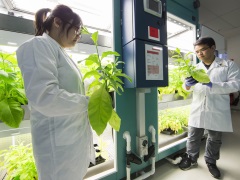Features
Putting the carboxysome in crop plants
Date: 2018-09-13 13:14:10.0
Author: Jon Evans

ANU researchers hold modified tobacco
plants containing simplified carboxysomes.
Photo: The Australian National University.
Concerns over the use of food crops as biofuel feedstocks has been a prime factor in encouraging scientists to search for possible non-food feedstocks. One potential candidate is cyanobacteria, ancient photosynthetic bacteria also known as blue-green algae, which studies have shown could be used as a source of various biochemicals and biofuels, including ethanol.
Now, a team of scientists from the Australian National University (ANU) has demonstrated an alternative way that cyanobacteria could benefit the production of biofuels and biochemicals. This is by letting food crops such as wheat take advantage of their more efficient photosynthesis machinery, increasing the yields of these crops and helping to ensure their use as a biofuel feedstock has minimal impact on food supplies.
"For the first time, we have inserted tiny compartments from cyanobacteria into crop plants that form part of a system that could lead to a 60% increase in plant growth and yield," said team leader Ben Long at ANU.
An essential component of the photosynthesis machinery in both plants and cyanobacteria is an enzyme called Rubisco (ribulose-1,5-bisphosphate carboxylase/oxygenase), which performs the first step in converting carbon dioxide into sugars. In crop plants, this process occurs in chloroplasts and isn’t very efficient. This is both because carbon dioxide can only diffuse passively into the plant cell, meaning it’s never present in the chloroplast at very high concentrations, and because oxygen competes with carbon dioxide for access to Rubisco.
The process occurs differently in cyanobacteria, probably as a result of these bacteria evolving while oxygen levels in the Earth’s atmosphere were increasing. Cyanobacteria immediately convert any carbon dioxide entering the cell into bicarbonate. This bicarbonate is then transported to a cellular compartment known as a carboxysome, which also houses all the cell’s Rubisco. Here, the bicarbonate is converted back into carbon dioxide, which cannot escape from the carboxysome and so builds up to high concentrations that enhance the efficiency of Rubisco, allowing it to generate sugar three times faster than the Rubisco in crop plants.
Scientists have long realised the potential benefits of transferring this process into crop plants, but it is a daunting prospect, requiring the engineering of a complex metabolic process. The carboxysome itself is made up of thousands of polypeptides comprising at least nine different types. So Long and his team decided to see of they could produce a simplified version of the carboxysome, for insertion in the chloroplasts of a tobacco plant.
Rather than nine different polypeptides, they decided to insert genes for just two polypeptides that they thought would self-assemble to produce a simplified carboxysome, together with two genes coding for subunits of Rubisco that should anchor themselves to the inner wall of the carboxysome. These two Rubisco genes were designed to replace the tobacco plant’s own Rubisco genes. All of the genes came from a species of cyanobacteria called Cyanobium marinum.
As Long and his team report in a paper in Nature Communications, their approach basically worked. The two polypeptides self-assembled into carboxysomes containing Rubisco within the tobacco chloroplasts. Some of these carboxysomes were more elongated than normal and didn’t trap carbon dioxide as well, but they were still able to perform the first step in converting carbon dioxide to sugars.
This work is still at an early stage, as the engineered tobacco cells still lack the ability to concentrate carbon dioxide in their carboxysomes via bicarbonate, but it represents an impressive first step. "We still have a lot of work to do, but achieving this in tobacco plants was an absolute essential step that has shown us we can expect to see crops with functional carbon dioxide-concentrating mechanisms in the future, producing higher yield," said Long.
The views represented here are solely those of the author and do not necessarily represent those of John Wiley and Sons, Ltd. or of the SCI.
Displaying 2 keywords used to tag this article:
- DG6582 Mens Moncler Down Jackets Gr
- Jules Audemars-Australia Best Quali
